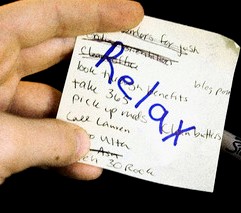As the first wave of Baby Boomers begins retiring, they've never been busier. While many have retired, most are still busy with careers, hobbies, volunteer work, and caregiving for multiple generations of family.
Relaxation may seem like just a distant dream, but keeping your mind and body relaxed can mean a longer, healthier life. Try these simple relaxation exercises for a breath of peace and sanity.
 Breathe: Deep, rhythmic breathing can calm jangled nerves and restore scattered focus. It's absolutely free, and you can do it anytime and anywhere. Simply sit or stand quietly and bring your focus to the rhythm of your breathing. Pull the breath deep into the lowest level of the lungs, inflating them fully. Gradually slow your breathing until you're completing 6 inhale/exhale cycles per minute. So breathe in for a count of 5 and out for a count of 5, for a total of 10 seconds per breath. Within just a couple of minutes you'll begin to feel calmer, quieter and more centered.
Breathe: Deep, rhythmic breathing can calm jangled nerves and restore scattered focus. It's absolutely free, and you can do it anytime and anywhere. Simply sit or stand quietly and bring your focus to the rhythm of your breathing. Pull the breath deep into the lowest level of the lungs, inflating them fully. Gradually slow your breathing until you're completing 6 inhale/exhale cycles per minute. So breathe in for a count of 5 and out for a count of 5, for a total of 10 seconds per breath. Within just a couple of minutes you'll begin to feel calmer, quieter and more centered.
Visualize: I think of visualization exercises as mini-vacations. Take a few minutes in a quiet place to visualize a favorite location that makes you feel peaceful, safe or joyful. It could be a shimmering beach, a misty forest, or a sunlit garden--whatever floats your boat. Make your special place come to life by using all your senses to fill in the details. What are the unique smells of your place? Can you hear the birds singing or the waves crashing? How does the air feel against your skin? Escaping to your special place, even for a few minutes, can bring down your levels of stress hormones and calm your anxiety.
Walk: For especially ansty Boomers, walking is a great alternative to meditation. The rhythmic nature of the walking motion has a calming effect, and even moderate aerobic exercise releases feel-good brain chemicals. Turn your walk into a meditative event by focusing on each of your senses and on how your body moves through space: Is your stride symmetrical and rhythmic? Does your weight roll through each foot evenly? How far do your arms swing? Is your gaze on the horizon or the ground beneath your feet? Can you feel your breathing deepen and your heart rate increase?
Balance: If you've started experiencing trouble keeping your balance as you walk, the thought of doing balance exercises may seem stressful. But keeping your physical balance requires that you tap into your inner balance. Start with a simple tandem stance: one foot directly in front of the other, heel touching toe. Bring your focus into your center of gravity, brace your abdominal muscles, and allow your energy to move through your center into the floor, so that gravity anchors you. The more mentally agitated you are the harder it will be to balance. To keep your balance, stay calm and focused.
Stretch: Your muscles are often the physical receptacles of your mental tension. (Feel that headache or pain in your neck?) I've even seen spasming muscles mistaken for a heart attack! Stretching and myofascial release techniques allow your muscles to release that tension. See this blog post for additional tips to improve stretching and flexibility. The flexibility and extra range of motion you'll enjoy are just added bonuses.
Run: Vigorous aerobic exercise is generally energizing rather than relaxing, but a steady diet of regular vigorous exercise can help you blow off steam and manage stress. Running or other vigorous exercise releases a burst of endorphins, and it's especially handy for anxiety that bleeds over into anger. Just be careful that your anxiety doesn't exceed your fitness level or you might overdo it. If that's the case, you may want to seek out a professional counselor.
The connections between mind and body are real and powerful. These relaxation exercises can help you tap into that connection for the benefit of both mind and body.
Tell us about your favorite relaxation techniques in the comments section.
(Image credit: Sasha Wolff)


